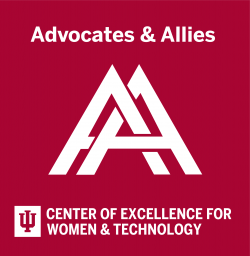As we finish our first full month of the semester, we are starting October (LGBTQ+ History Month) by talking about supporting LGBTQ+ people in your office/department. Millions of people in the United States belong to the LGBTQ+ community (Gallup, 2021), which means that even if you don’t consciously know it, there’s probably at least one person around you who is LGBTQ+. Visit the LGBTQ+ Culture Center’s website for more information about ongoing events and trainings that can help you grow as an ally for gender and sexuality equity.

Reflect: What’s in a name? - Language Within the LGBTQ+ Community
The language used to describe gender and sexuality evolves to reflect continuously changing knowledge around these identities. Because of this, it can be hard to understand just how people describe themselves in the LGBTQ+ community. Check out this informative (and frequently updated) glossary from PFLAG to learn about the variety of terms used within the LGBTQ+ community. Another aspect of language for this community is pronouns. Using people’s pronouns isn’t new – we’ve all used them in one form or another (e.g., “he didn’t turn in his work”). Following the pronouns someone has asked us to use for them shows that we respect and see them for who they are. MyPronouns.org provides in-depth resources on pronouns. Similarly, we must always respect someone’s name, as it’s not uncommon for trans and non-binary people to change their name after coming out. Calling a trans person by their chosen name is integral to including them within your working/learning environment, and can lead to a decrease in negative mental health outcomes (Russell, Pollitt, Li, & Grossman, 2018).
Learn: LGBTQ+ Student, Staff, and Faculty Experiences
While scholars have discussed growth in climate and support for LGBTQ+ students, that progress is “not consistent” (para. 7; Renn, 2017). For example, these students in STEM majors view their fields as having a “bro culture,” which objectified/sexualized cisgender women and was rife with assumed heterosexuality, hypermasculinity, and microaggressions that erase LGBTQ+ people or downplay their intelligence (Miller, Vaccaro, Kimball, & Forester, 2021). For faculty and staff, discrimination (despite federal level rulings that include LGBTQ+ people under anti-discrimination protections [Liptak, 2021]) and tokenization is common. Recently, Dr. Rachel Tudor, an indigenous and trans professor, won her years-long legal battle with Southeastern Oklahoma State University after the 10th Circuit court ruled that the university denied her tenure promotion because of her gender and retaliated against her when she filed complaints (Planas, 2021). Pryor and Hoffman (2020) found that publicly out LGBTQ+ student affairs practitioners often burn out as a result of being expected to teach a large number of people about LGBTQ+ topics/issues without proper administrative support or funding.
Change: Creating Inclusive Environments for Gender and Sexuality Equity
- Respect pronouns and names: One way to create an inclusive environment for gender diversity is to normalize the recognition/use of pronouns by introducing yourself with your name and pronouns in every meeting or including them in your email signature. Many university systems, such as Canvas, include the option to select pronouns that are visible but do not require announcement. Encourage others to follow your example, but don’t force anyone to share their pronouns – this can make anyone who is not ready to share uncomfortable.
- Use gender-neutral language: Gender-neutral language is an important step towards making space for the diversity of gender. If you are referring to someone and you don’t know their pronouns, default to using “they” (e.g., “I saw them speak this weekend”). Using gender neutral language also prevents you from assuming sexuality. Instead of saying “husband” or “girlfriend,” use words like “significant other” or “partner” to make space for all kinds of relationships.
- Interrogate microaggressions you hear: There are plenty of microaggressions that LGBTQ+ people hear every day, such as “It’s a shame you’re a lesbian, you’re so pretty” or “you look better in that dress than I would!” If you hear microaggressions that question/antagonize the gender and/or sexuality of someone around you, simply ask “What makes you say that?” Doing this forces the person to justify why they thought it was okay to say something like that.
Weekly Resource Recommendations
- Book: Trans People in Higher Education – Dr. Genny Beemyn uses personal narrative and research to describe the small- and large-scale experiences of trans people in higher education.
- Video: Black & LGBTQ+: At the intersection of race, sexual orientation, and identity – Listen to this webinar to learn about the experiences of Black LGBTQ+ individuals in the United States.
- Article: LGBTQ Students on Campus: Issues and Opportunities for Higher Education Leaders - Dr. Kris Renn discusses the primary issues facing LGBTQ+ students in higher education, with suggestions for change that can be adapted for departments/offices.
- Podcast: Life Kit: Making the Workplace More Equitable for Trans People – This episode of Life Kit features Chase Strangio, one of the lawyers who fought last summer to get LGBTQ people protected under Title VII, to discuss how to create a better workplace for trans people.
Get these tips delivered to your mailbox!
We send these tips every Tuesday during the fall & spring semesters to our mailing list. If you are not already on our mailing list you can request to be added by completing the form below.

